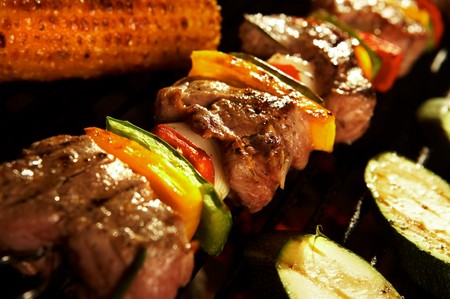Grilling and Summer Chilling

Grilling is just something you do during the summer. In some places, you can do it all year long, in others, you can find people fitting into their winter jackets, grilling up steaks on their Weber while the snow falls on the metal grates. So with summer officially starting June 20 here are some tips to help you get the most out of the barbecue.
Pick your fuel properly.
If you like to speed up the process of getting the food from the grill to your guests, gas is the way to go. Natural gas burns very hot, and obviously lights with the flick of a match, or click of a dial. Your heat box can fire up faster with propane, but it doesn’t give the same flavor as wood or charcoal. Cooking over wood allows you to impart flavor (depending on the type of wood like apple, hickory, oak, etc.) into the meat, bread, fruits or veggies atop the flame.
But you’re also cooking on top of the flames, which are not nearly as hot as the coals that remain after the light burns out. All charcoal is wood that has been burned and had all its volatile components (the smoke) removed. Cooking with natural charcoal (which also gives your grub some taste) is my favorite, but you can opt for the bad boy/girl Christmas presents shaped into squares as well. If you want speed, pick gas, if you want to impart flavor, use wood or charcoal.
Grease your grates.
A little secret to keep your food from sticking is oiling up the metal. That is if you want the cool looking grill marks. First of all, take a wire brush and scrub; get all the grime off the grill so you have a clean surface to work with. Fire up your flame and once your grill stops smoking, when all you’re left with are embers, take a pair of tongs, your cooking oil of choice and dampen a clean, kitchen towel with the oil. Take your tongs and rub the hot wires with the towel, making sure not to light it on fire, this will help whatever you’re charring come off easier afterwards.
Marinate your meat.
Something as simple as taking Italian dressing and throwing your chicken in a sealable plastic bag slathered in sauce creates a lot of flavor the longer it lies in the fridge. You can do the same for beef, pork, lamb, veggies and fruits. Depending on ingredients in your marinade, it might also help break down some of the tissue in the meat and make it tender.
I use all kinds of herbs and spices like cumin, paprika, chili powder, garlic, rosemary, thyme, salt, fresh cracked pepper, red or white wine, vinegars, various citrus juices and even some soy sauce. There are plenty of recipes online but you can also go your own way and use some trial and error to get the flavor combination you’re most comfortable with.
Let your food talk to you.
Whatever you’re cooking, it’ll tell you when it’s ready to flip, turn, or take off. Most meats stick to the grill until the area touching the metal is caramelized (or well oiled), ready to release itself from the hot metal. If you try to flip too soon, you’ll rip off parts of the food you’re cooking, ruining the look you’re going for. If you want those diamond-shaped marks on your meat, here’s how to get it done.
Think of your grill as a clock. Take the slab of steak and set it where the ends point at 5 o’clock and 11 o’clock respectively. The meat will release when it’s ready, so lift it up just enough so that you can see how well the marks have been made. Once the lines are to your liking, rotate the meat about a quarter turn clockwise (or to 7 o’clock and 1 o’clock on the grill time piece).
Again wait until the lines are made, and flip the meat over, staying in the same spot. Rotate a quarter turn counterclockwise (or back to its original spot) and let it sear and then you’re done with the diamonds on both sides. If the meat is not done to the temperature you’d like, you can finish it in the oven to your desired temp. Have a thermometer available, digital is the most convenient, and for chicken or pork, cook to 165 degrees to be safe, same for any ground meat. Beef would be rare around 130 degrees, well-done at 170.
Take a break and rest, your meat.
When you’re grilling meats, you’re pumping heat into inside and in turn, you’re cooking juices out. When you have reached the appropriate temperature, allow the meat to rest, and the juices to chill out and return back into the grilled item. Resting will take about seven to ten minutes, and if you cut it right away, you’ll be letting out all the juices and a great deal of flavor on the cutting board instead of keeping it in.
These are just a few basic tips and tricks to help you on your way to grilling greatness. Whether or not it’s gas or charcoal, if you want perfect grill marks or to keep your food from sticking, these little things will make your life and barbecue a little more enjoyable.
Copyright TableAgent.com
© Restaurant Agent Inc.